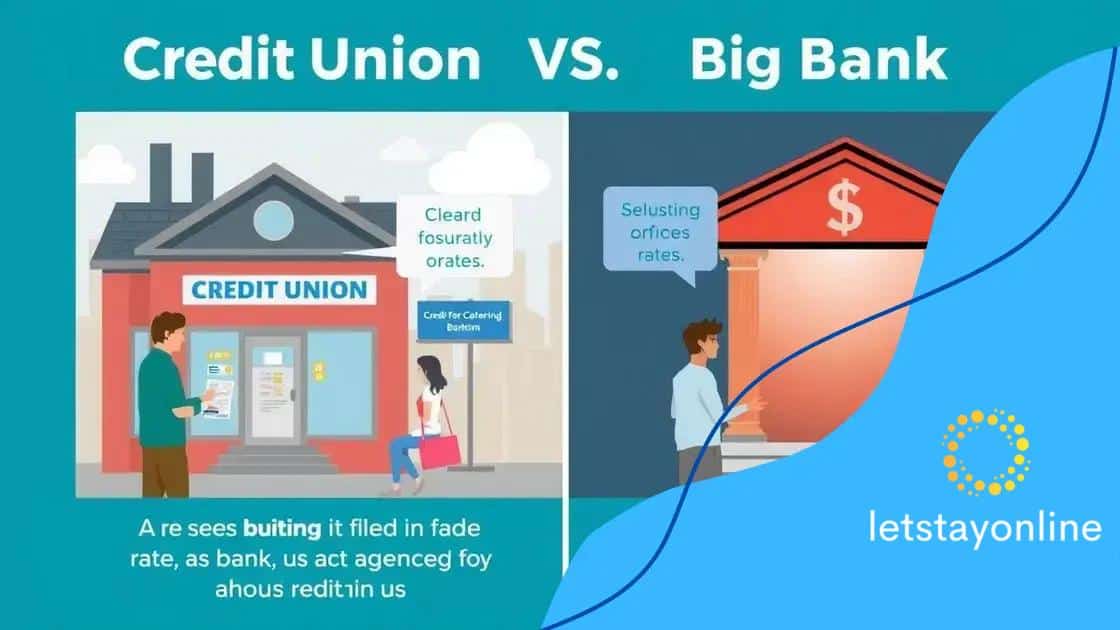How credit unions are competing with big banks

Credit unions are competing with big banks by offering lower fees, better interest rates, and personalized services, while actively supporting their communities through financial education and local business loans.
How credit unions are competing with big banks reveals a shift in the financial landscape. Many consumers are seeking alternatives that emphasize customer care over profits. Curious about how these institutions are gaining ground?
Understanding the unique advantages of credit unions
Credit unions offer unique benefits that differentiate them from traditional banks. Understanding these advantages can help consumers make informed choices. One of the primary benefits is the member-focused approach. Unlike banks that prioritize profits, credit unions are owned by their members, which means they aim to serve their community better.
Community Engagement
Another advantage of credit unions is their deep connection to the community. Since they operate locally, they understand the specific needs of their members. This often results in tailored services and programs that support local initiatives.
- Personalized services that cater to individual financial needs.
- Lower fees on loans and better rates on savings.
- Investment in local development projects and charities.
Moreover, credit unions often provide lower interest rates on loans compared to big banks. This can significantly save members money. Many credit unions also offer financial education programs to help members manage their money wisely. They often host workshops that teach budgeting, saving strategies, and even first-time home buying.
Innovative Financial Products
In addition to lower rates, credit unions typically offer a variety of financial products. They can provide unique loans or savings accounts catered to specific community needs. For instance, some may offer special loans for first-time home buyers or programs to assist with education costs. With their focus on community, these institutions look for ways to support their members in every aspect of their financial journey.
The customer service at credit unions is also noteworthy. Members often report a higher level of service and personalized attention that brings peace of mind in financial dealings. This aspect can be reassuring for those who may feel overwhelmed by traditional banking systems. By offering customized solutions and fostering relationships, credit unions create a sense of trust and reliability.
How credit unions leverage community ties

Credit unions leverage community ties in remarkable ways that benefit both their members and the neighborhoods they serve. By fostering close relationships within the local community, they can understand the specific needs of their members better than bigger banks. This connection often results in services that are more closely aligned with what people actually want.
Building Stronger Connections
Credit unions engage with their communities through various initiatives. They participate in local events, sponsor youth sports teams, and support charitable organizations. These activities not only enhance their visibility but also create a sense of loyalty. Members appreciate having a financial institution that invests in their community.
- Local events: Many credit unions organize or participate in community fairs, making financial services more accessible.
- Financial literacy programs: They often conduct workshops to help community members learn about budgeting, saving, and managing credit.
- Charitable contributions: Credit unions frequently donate a portion of their profits to local non-profits, enhancing community welfare.
This community-focused approach not only builds trust but also encourages members to support their credit union actively. When individuals see their credit union genuinely invested in their community, they often choose to do business there. This leads to a win-win situation: members receive better services, and the credit union strengthens its member base.
Tailored Financial Solutions
Another aspect of leveraging community ties is the ability to offer tailored financial solutions. Since credit unions know their members well, they can create products and services that meet specific local needs. For instance, they may offer loans targeted at local businesses or programs supporting first-time homebuyers within the community.
This attentiveness allows credit unions to cater to their members’ unique circumstances, such as seasonal employment in agriculture or tourism. By providing personalized services, they ensure that their members feel valued and understood, which enhances member retention.
Innovative technology in credit unions
Innovative technology in credit unions is revolutionizing the way they serve their members. By embracing advancements, these institutions are making banking more accessible and efficient. With the rise of smartphones and online platforms, credit unions are adopting tools that enhance customer experience and streamline operations.
Mobile Banking Applications
Many credit unions now offer mobile banking applications that allow members to manage their finances on the go. Members can easily check balances, pay bills, and transfer funds anytime, anywhere. These apps are user-friendly and prioritize security, making them a convenient option for busy lifestyles.
- Deposits on the go: Members can deposit checks using their smartphone cameras, making banking even simpler.
- Instant notifications: Account alerts keep members informed about their transactions.
- Budgeting tools: Many apps offer features that help users track spending and save for goals.
In addition to mobile apps, credit unions are also utilizing online platforms for member services. Through their websites, they provide easy access to information about loans, interest rates, and financial education resources. These platforms help members make informed decisions about their finances without needing to visit a branch.
Blockchain Technology
Some credit unions are even exploring blockchain technology to enhance security and transparency in transactions. Blockchain can help reduce fraud and ensure that transactions are processed efficiently. This can be especially beneficial for larger transactions or for members who often deal with international payments.
The use of innovative technologies also extends to customer service. Many credit unions are implementing chatbots and online support tools that provide 24/7 assistance. This means members can get help with their questions, no matter the time of day. As technology continues to evolve, credit unions strive to adapt, ensuring they meet the needs of their members effectively.
Comparing fees and rates: credit unions vs. big banks

When it comes to comparing fees and rates, understanding the differences between credit unions and big banks is essential. Credit unions typically have lower fees and better rates than their larger counterparts. This difference can significantly impact how much you pay for banking services over time.
Lower Fees at Credit Unions
One of the most notable advantages of credit unions is their lower fees. Many credit unions do not charge monthly maintenance fees for checking accounts. Furthermore, they often have fewer fees for services such as:
- Overdrafts: Credit unions generally offer more lenient overdraft policies with lower fees.
- ATM usage: Members can access a network of ATMs without incurring transaction fees, unlike big banks.
- Account closures: Many credit unions allow you to close accounts without penalty, while banks may charge a fee.
This commitment to minimizing fees is part of their mission to serve their members rather than maximize profits. As a result, many consumers find that switching to a credit union can save them money in the long run.
Competitive Interest Rates
In addition to lower fees, credit unions often provide better interest rates on loans and savings accounts compared to big banks. Because they are member-owned, they are in a unique position to offer:
- Lower loan rates: Credit unions typically offer lower rates on personal loans, auto loans, and mortgages, which can save members substantial amounts over time.
- Better savings rates: With higher interest rates on savings accounts, credit unions enable members to grow their money faster.
- Special promotions: Many credit unions offer promotional rates for new accounts, making it even more appealing for new members to join.
This combination of lower fees and competitive interest rates makes credit unions a compelling choice for many individuals and families. The transparency in their fee structures allows members to understand exactly what they’re paying for, fostering trust and satisfaction.
Success stories: credit unions making a difference
Success stories from credit unions demonstrate their ability to make a significant difference in the lives of their members and communities. These institutions often provide resources and support that empower individuals and families to achieve their financial goals. Through their unique approach to banking, credit unions are not just financial institutions; they are community partners.
Empowering Members Through Education
Many credit unions invest in financial education programs. These programs help members learn how to budget, save, and manage debt effectively. For example, a local credit union might offer workshops on:
- Saving for college: Providing information and resources for families looking to fund their children’s education.
- First-time home buying: Guiding members through the mortgage process to help them purchase their first home.
- Debt management: Offering strategies and support for members struggling with debt.
These educational initiatives not only improve financial literacy but also foster a sense of community among members. As individuals gain knowledge, they can make better financial decisions that positively impact their lives.
Supporting Local Businesses
Credit unions also play a crucial role in supporting local businesses. They offer small business loans with favorable terms that help entrepreneurs get started or expand their operations. By doing so, they contribute to job creation and economic development within their communities. Successful businesses often share their stories, highlighting how their credit union helped them thrive.
For instance, a small bakery might receive a loan to purchase new equipment, leading to increased production and customer satisfaction. These stories illustrate the direct impact that credit unions have on local economies, providing essential support at critical times.
In addition to financial assistance, many credit unions participate in community events and initiatives that further strengthen their ties with local members. They may sponsor festivals, host health fairs, or partner with local organizations to provide essential services. These efforts create a lasting impression and show members that their credit union is more than just a place for transactions; it’s a part of their community.
FAQ – Frequently Asked Questions about Credit Unions
What are the main benefits of joining a credit union?
Credit unions offer personalized services, lower fees, and better interest rates compared to big banks.
How do credit unions support their communities?
Credit unions engage in local events, provide financial education programs, and offer loans to local businesses.
Are the fees associated with credit unions lower than those of banks?
Yes, credit unions generally have lower fees for services like checking accounts and loans.
What kinds of financial education do credit unions provide?
Many credit unions offer workshops on budgeting, saving for college, and managing debt to empower their members.






